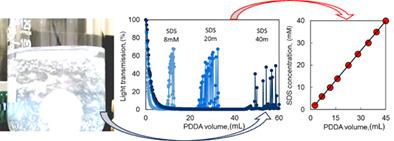当前位置:
X-MOL 学术
›
J. Surfactants Deterg.
›
论文详情
Our official English website, www.x-mol.net, welcomes your feedback! (Note: you will need to create a separate account there.)
Determination of Sodium Dodecyl Sulfate via Turbidimetric Titration with Poly(Diallyldimethylammonium Chloride)
Journal of Surfactants and Detergents ( IF 1.6 ) Pub Date : 2020-06-19 , DOI: 10.1002/jsde.12428 Dorota Ziółkowska 1 , Jan Lamkiewicz 1 , Alexander Shyichuk 1
Journal of Surfactants and Detergents ( IF 1.6 ) Pub Date : 2020-06-19 , DOI: 10.1002/jsde.12428 Dorota Ziółkowska 1 , Jan Lamkiewicz 1 , Alexander Shyichuk 1
Affiliation

|
Titration of sodium dodecyl sulfate (SDS) solution with poly(diallyldimethylammonium chloride) (PDDA) results in the formation of colloidal dispersion and gradual increase of turbidity. The titration end point can be determined in different ways, depending on both titrant concentration and optical detector used. The maximum value of turbidity depends on concentration of the titrant solution. An immersion probe is applicable to measure turbidity changes only at low concentrations of the colloidal dispersion. An external optical sensor is well suitable at both low and high concentrations of PDDA titrant. Near to the equimolar ratio of the analyte and titrant, large floccules are formed and turbidity values undergo chaotic fluctuations. Calibration graphs for SDS determination are straight lines. Determination range is from 0.2 to 40 mg L−1.
中文翻译:

聚二烯丙基二甲基氯化铵比浊滴定法测定十二烷基硫酸钠
用聚二烯丙基二甲基氯化铵(PDDA)滴定十二烷基硫酸钠(SDS)溶液可导致胶体分散液的形成和浊度的逐渐增加。可以根据滴定剂浓度和所用光学检测器,以不同方式确定滴定终点。浊度的最大值取决于滴定剂溶液的浓度。浸入式探头仅在低浓度的胶体分散液中适用于测量浊度变化。外部光学传感器非常适合低浓度和高浓度PDDA滴定剂。接近分析物和滴定剂的等摩尔比时,会形成大絮状物,浊度值会发生混乱的波动。SDS测定的校准图为直线。测定范围为0.2至40 mg L-1。
更新日期:2020-06-19
中文翻译:

聚二烯丙基二甲基氯化铵比浊滴定法测定十二烷基硫酸钠
用聚二烯丙基二甲基氯化铵(PDDA)滴定十二烷基硫酸钠(SDS)溶液可导致胶体分散液的形成和浊度的逐渐增加。可以根据滴定剂浓度和所用光学检测器,以不同方式确定滴定终点。浊度的最大值取决于滴定剂溶液的浓度。浸入式探头仅在低浓度的胶体分散液中适用于测量浊度变化。外部光学传感器非常适合低浓度和高浓度PDDA滴定剂。接近分析物和滴定剂的等摩尔比时,会形成大絮状物,浊度值会发生混乱的波动。SDS测定的校准图为直线。测定范围为0.2至40 mg L-1。


























 京公网安备 11010802027423号
京公网安备 11010802027423号